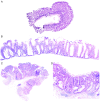Chemoprophylaxis of precancerous lesions in patients who are at a high risk of developing colorectal cancer (Review)
- PMID: 38628384
- PMCID: PMC11019464
- DOI: 10.3892/mi.2024.149
Chemoprophylaxis of precancerous lesions in patients who are at a high risk of developing colorectal cancer (Review)
Abstract
The diagnostics of colorectal cancer (CRC) and precancerous lesions in the colon is one of the most urgent matters to be considered for the modern protocols of complex examination, recommended for use from the age of 45 years, and including both instrumental and laboratory methods of research: Colonoscopy, CT colonography, flexible sigmoidoscopy, fecal occult blood test, fecal immunohistochemistry test and stool DNA test Nevertheless, the removal of those precancerous lesions does not solve the issue, and, apart from the regular endoscopic monitoring of patients who are at a high risk of developing CRC, the pharmacological treatment of certain key pathogenic mechanisms leading to the development of CRC is required. The present review to discusses the function of β-catenin in the transformation of precancerous colorectal lesions into CRC, when collaborating with PI3K/AKT/mTOR signaling pathway and other mechanisms. The existing methods for the early diagnostics and prevention of discovered anomalies are described and categorized. The analysis of the approaches to chemoprophylaxis of CRC, depending on the results of endoscopic, morphological and molecular-genetic tests, is presented.
Keywords: biological therapy; cancer stem cells; colorectal cancer; inflammatory bowel disease.
Copyright: © 2024 Ogurchenok et al.
Conflict of interest statement
The authors declare that they have no competing interests.
Figures



Similar articles
-
Fecal occult blood test for colorectal cancer screening: an evidence-based analysis.Ont Health Technol Assess Ser. 2009;9(10):1-40. Epub 2009 Sep 1. Ont Health Technol Assess Ser. 2009. PMID: 23074514 Free PMC article.
-
Colorectal cancer screening for average-risk adults: 2018 guideline update from the American Cancer Society.CA Cancer J Clin. 2018 Jul;68(4):250-281. doi: 10.3322/caac.21457. Epub 2018 May 30. CA Cancer J Clin. 2018. PMID: 29846947
-
Colorectal cancer screening: comparison of transferrin and immuno fecal occult blood test.World J Gastroenterol. 2012 Jun 7;18(21):2682-8. doi: 10.3748/wjg.v18.i21.2682. World J Gastroenterol. 2012. PMID: 22690078 Free PMC article.
-
A Review of Colorectal Cancer Detection Modalities, Stool DNA, and Fecal Immunochemistry Testing in Adults Over the Age of 50.Cureus. 2016 Dec 16;8(12):e931. doi: 10.7759/cureus.931. Cureus. 2016. PMID: 28097082 Free PMC article. Review.
-
Screening for Colorectal Cancer: Updated Evidence Report and Systematic Review for the US Preventive Services Task Force.JAMA. 2021 May 18;325(19):1978-1998. doi: 10.1001/jama.2021.4417. JAMA. 2021. PMID: 34003220
References
-
- Pritchett N, Spangler EC, Gray GM, Livinski AA, Sampson JN, Dawsey SM, Jones RR. Exposure to outdoor particulate matter air pollution and risk of gastrointestinal cancers in adults: A Systematic review and meta-analysis of epidemiologic evidence. Environ Health Perspect. 2022;130(36001) doi: 10.1289/EHP9620. - DOI - PMC - PubMed
Publication types
LinkOut - more resources
Full Text Sources
Miscellaneous
